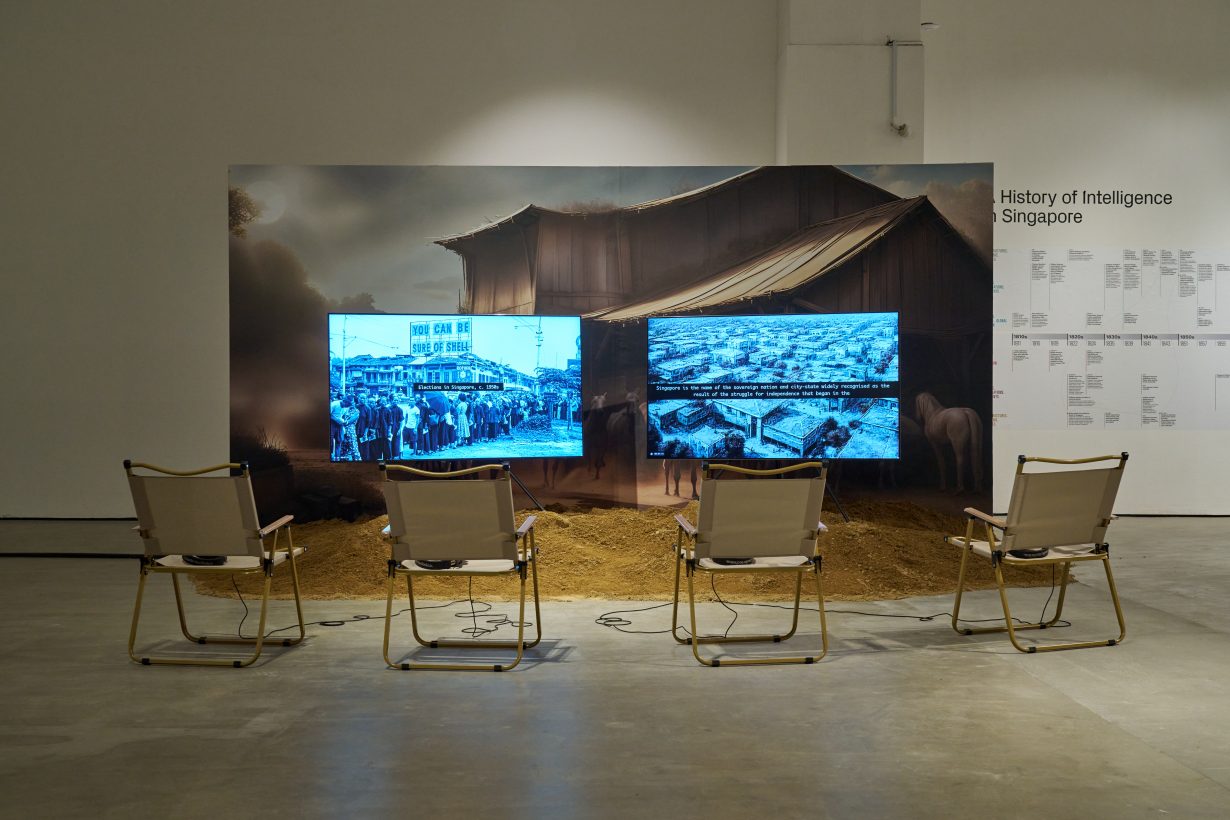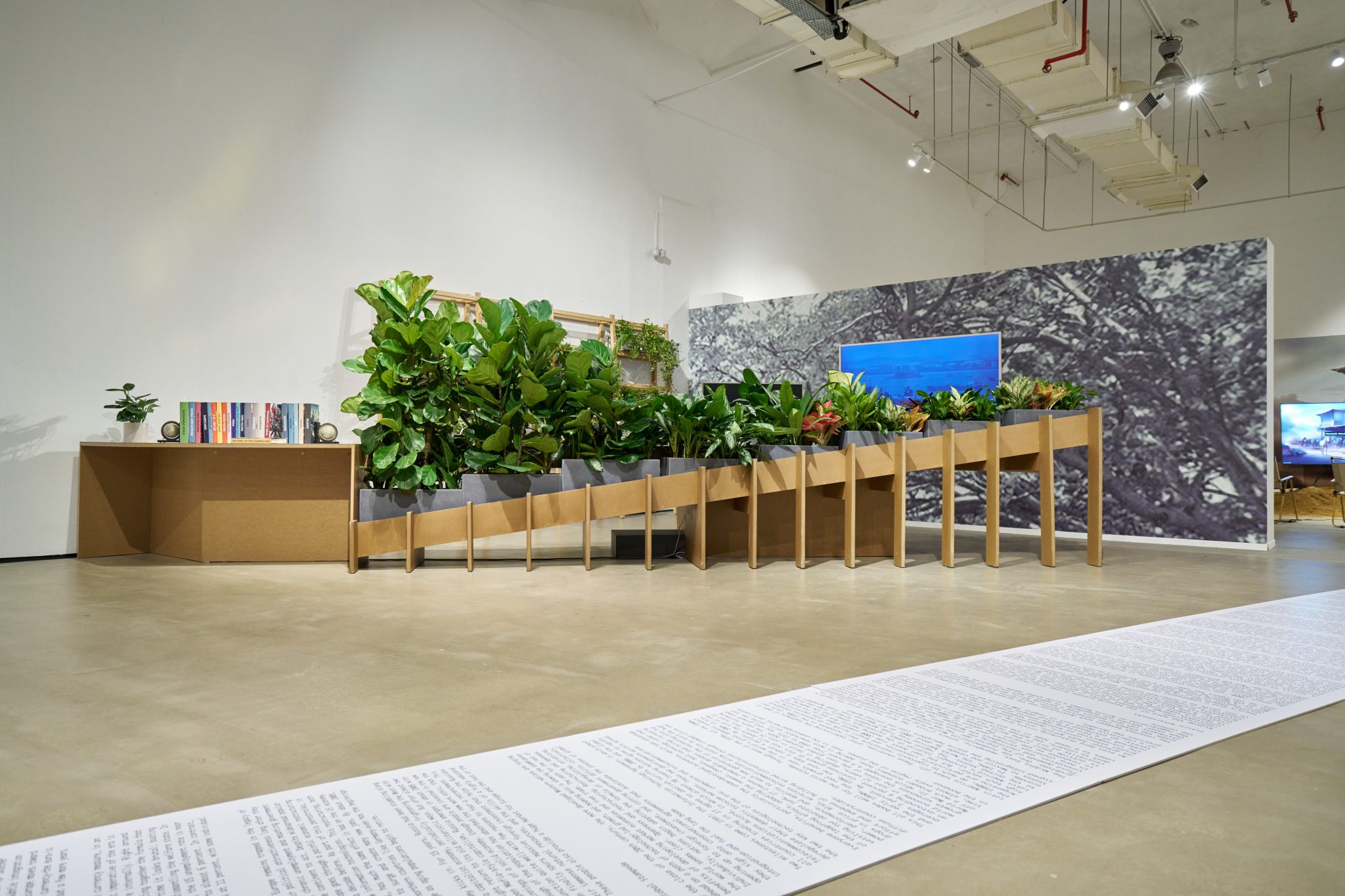Post-Production Fever at ArtSpace@Helutrans unpacks how labour shapes our world
Oil is Singapore’s dirty secret. The self-proclaimed image of the city-state as a Garden City belies its extremely un-green status as a petrochemical hub that facilitates the global trade in fossil products. The two faces of the country are captured in Ho Rui An’s installation A Petropolis in a Garden with a Long View (2024), which depicts a corporate office-space brimming with indoor plants, as well as examples of Singapore’s long and little-publicised dependence on oil. On the table is The Art of the Long View (1991) by the influential ‘futurist’ Peter Schwartz, which documents the scenario-planning techniques developed, when he was employed by Shell during the early 1980s, to anticipate the imminent global oil-crisis. His forecasting techniques were adopted by the Singapore government two years after the book’s publication. Various laser-engraved transparent plaques can also be seen on the table, including one that features the then-chairman of Singapore’s central bank, Goh Keng Swee, felling a tree on Pulau Bukom to mark the construction of a Shell petroleum refinery on the island. On the wall, a TV monitor shows found footage of supertankers (captured from airplanes) entering Singapore – a sight seldom seen in tourist marketing. The message is clear: despite the greenwashing, Singapore’s developmental trajectory is deeply complicit with the petrochemical industry.
Ho’s solo exhibition is concerned with two kinds of production: the forces driving the creation of goods and services, and representations of such processes that might clarify or obfuscate the material realities. The exhibition is split into three parts. The first focuses on factory labour; the second on the oil industry; and the third on AI and ethics. Ho makes videos, prints and installations, several of which are included in this exhibition, but the backbone of his practice lies in his deeply researched performance-lectures, which draw from political and economic theory, visual culture and history. Performed as live events in front of an audience, the contents of these lectures are adapted into voiceovers for his longer videoworks.
What this exhibition demonstrates is that Ho is first and foremost a conceptual thinker and researcher, rather than a maker. Oil Media Archive (2018–) is a collection of reading materials, comprising books and prints exploring Singapore’s oil industry and the rise of oil as a commodity on the global market. Another work is a printout of an essay that has been placed on the floor like a long carpet. Written by Schwartz and Peter Leyden in 1997, ‘The Long Boom: A History of the Future, 1980–2020’ is a classic of neoliberal thought that envisages a future of worldwide prosperity, freedom and peace driven by free trade and new technologies – a scenario that we can resolutely say never came to be.

The main appeal of this show lies in Ho’s original combinations of political, economic and historical discourses to make seductive arguments that are carried by the associative qualities prompted by an image or turn of phrase. Pleasure is reached through this movement of thought rather than the veracity of the conclusions proposed by such arguments. In 24 Cinematic Points of View of a Factory Gate in China (2023), Ho explores the genre of the ‘factory film’ by going on a unique trek through representations of industrial labour in European, American and Chinese cinema, from the Lumière brothers’ first picture of workers leaving a factory to Chinese Maoist films portraying worker solidarity, while drawing inferences about the different ideologies that influenced how labour was represented by each filmmaker. Culminating in these representations is surveillance footage of entrance gates to factories owned by Chinese companies listed on the New York Stock Exchange, which shows very few people coming in and out, casting doubt on the revenue figures these companies reported. This secret footage sought to expose fraud, but Ho aims to demonstrate ‘a contemporary scenography of late capitalism where there appears to be barely any workers leaving the factory’. (Some of this content has been used in another performance-lecture, The Economy Enters the People, 2021–22.) Ho documents the gates of these 24 companies through images that have been arranged in a grid, resembling the multiscreen setup in CCTV control rooms, capturing the quiet gates of these phoney Chinese firms. This static display is occasionally interspersed with clips from the Lumière film and others; more compelling is the voiceover, which discusses the historical relations between labour, technology and capital.
AI is a recurring theme. Ho mostly uses it as an image-generation tool, such as in Fuelling Apocalypse (2024), which tackles Singapore’s war profiteering during the 1960s and 70s (the country supplied oil to both sides in the Vietnam war). He also discusses its broader ramifications for our conceptions of history and society. The video Figures of History and the Grounds of Intelligence (2024) records a densely packed lecture-performance featuring critical discussions of ‘global villages’, cybernetics, the time-loop movie Edge of Tomorrow (2014), deep-learning models and the apolitical and amoral intelligence that AI embodies. As Ho points out: “The real problem with AI then is not that datasets can be biased, but that the neural network that trains the data is not that inherently biased towards any ethical position at all, as if one can imagine the future without first making judgements about the events of history.”
There are two channels to this video installation. The one on the left shows images prepared by Ho to illustrate his points, while that on the right features AI generating a live transcript and images inspired by Ho’s monologue. When I was there, images that corresponded to the contents of the voiceover included weird leftfield pictures like a mass of conjoined human flesh, as well as long stretches of grey static as the AI caught up with the processing. Although this all demonstrates how precocious and capricious AI can be, the visuals are still less satisfying than Ho’s elegant theorising.
Ho speaks of labour and intelligence in this show with the aim of scrutinising the ways neoliberal thought has infiltrated all manner of daily life. As for intelligence, if neoliberalism is the enemy, then Ho’s art is a committed and tireless force against it, gathering information about its strength, capabilities, locations and intentions; unlike AI, his intelligence has a strong ethical bias.
Post-Production Fever at ArtSpace@Helutrans, Singapore, 13 July – 11 August
